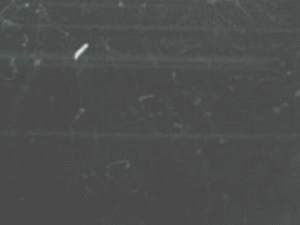A-level Physics (Advancing Physics)/Cloud Chambers and Mass Spectrometers

Cloud Chambers
[edit | edit source]The magnitude of the magnetic force on a moving charged particle is given by:
,
where B is the magnetic field strength, v is the speed of the particle and q is the charge on the particle. This force is exerted in a direction perpendicular to both the magnetic field and the direction of motion. If a charged particle enters a uniform magnetic field which is perpendicular to its velocity, then it will move in a circle, since there will be a force of constant magnitude acting on it in a direction perpendicular to its motion. Using the equation for centripetal force, we can derive a formula for the radius of this circle:
,
or if the particle moves at relativistic velocities:
,
where p is the momentum of the particle, m is the mass of the particle and γ is the Lorentz Factor. This equation makes sense. If the particle has a higher momentum, then its circle of motion will have a larger radius. A stronger magnetic field strength, or a larger charge, will make the radius smaller.
In a cloud chamber, particles enter a magnetic field, and also a liquid which they ionise. This ionisation causes the paths of the particles to become visible. When the particle loses its charge, its track ceases. When the particle loses momentum, the radius of the circle decreases, and so, particles spiral inwards. The direction of this spiralling depends on the direction of the magnetic field. If the direction of the magnetic field causes a positively charged particle to spiral clockwise, then it will cause a negatively charged particle to spiral anticlockwise. Cloud chambers can, therefore, be used to identify particles by their charge and mass.
Mass Spectrometers
[edit | edit source]Mass spectrometers work on a similar principle. Particles to be identified (such as nuclei) are accelerated using an electric field. Then, a velocity selector is used to ensure all the nuclei are at a known velocity - all the rest are discarded. These nuclei enter a uniform magnetic field where they move in a circle. However, they are only allowed to move half a circle, since they are collected at this point, and the number of particles arriving at each point is measured.

Velocity Selector
[edit | edit source]In the velocity selector, both a uniform electric field and a uniform magnetic field act on the particle. The only way a particle can travel through the velocity selector in a straight line is if the electric force on it is equal and opposite to the magnetic force on it. If this is not the case, the particle's path is bent, and so it does not get out of the velocity selector into the rest of the mass spectrometer. If we equate these two forces, we get:
,
where q is the charge on the particle, E is the strength of the uniform electric field, v is the velocity of the particle, and B is the strength of the uniform magnetic field. The charge may be eliminated from both sides:
Therefore:
This means that, by adjusting the strengths of the electric and magnetic fields, we can choose the velocity at which particles emerge from the velocity selector.

Finding Mass
[edit | edit source]The particles then move at a speed v into another uniform magnetic field. Here, as in the cloud chamber, the radius of the circle in which the particle moves is given by:
If we know the charge on the particle (for example, we know what element it is), we can measure the radius of the circle, and find the mass of the particle (i.e. what isotope it is, since neutrons have no charge) using the formula:
If we do not know the charge, then we can find the mass to charge ratio:
Questions
[edit | edit source]
Charge of electron = -1.6 x 10−19C
Mass of electron = 9.11 x 10−31kg
u = 1.66 x 10−27kg
1. An electron enters a cloud chamber, passing into a 0.1T magnetic field. The initial curvature (the reciprocal of its radius) of its path is 100m−1. At what speed was it moving when it entered the magnetic field?
2. The electron spirals inwards in a clockwise direction, as show in the diagram on the right. What would the path of a positron, moving with an identical speed, look like?
3. Using a 2T magnetic field, what electric field strength must be used to get a velocity selector to select only particles which are moving at 100ms−1?
4. Some uranium (atomic number 92) ions (charge +3e) of various isotopes are put through the velocity selector described in question 3. They then enter an 0.00002T uniform magnetic field. What radius of circular motion would uranium-235 have?










